First Look: Robbie Morrison Starts “Wildcats: Nemesis” Mini, World Doesn’t Care
By Russell Paulette
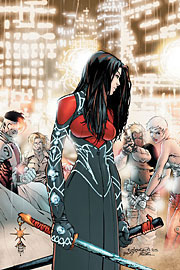 Yeah, the Wildcats were cool—I was a teenager, what do you expect? But then, I eventually drifted away from their ill-defined powers and motivations, their costumes and names with paper thin characterizations, and their drawn messy to perfection suits and hair. Had it, done with the beast. Along came Joe Casey, and he breathed life into a franchise that, frankly everyone had forgotten about and along the way converted me to life among the Kheribim. But then, nobody seemed to care, and they canceled his version of the book, too.
Yeah, the Wildcats were cool—I was a teenager, what do you expect? But then, I eventually drifted away from their ill-defined powers and motivations, their costumes and names with paper thin characterizations, and their drawn messy to perfection suits and hair. Had it, done with the beast. Along came Joe Casey, and he breathed life into a franchise that, frankly everyone had forgotten about and along the way converted me to life among the Kheribim. But then, nobody seemed to care, and they canceled his version of the book, too.
Enter Robbie Morrison. He has the distinction at Wildstorm of being the writer who made everyone give up on the Authority. To his credit, the zeitgeist of Ellis’s demented brainchildren was wrapping up, their fifteen minutes ticking, so by the time he inherited the title, they felt so year 2000 that it just felt like a photocopy of a photocopy of a line drawing of a relic from a bygone era. Whether their time had passed, or Morrison’s take didn’t work, the title became torpid, and I gave up after a few issues.
Next week sees the release of Wildcats: Nemesis, which is the first issue of a six-issue mini-series that is, presumably, going to give that franchise a shot-in-the-arm between now and sometime next year, when the More Famous Morrison and Jim Lee make everybody actually take notice. How does this first issue stack up?
Gone are any of the subtle machinations or boardroom backstabbings of the Casey era, only to be replaced with the above-related teenage “coolness.” In a word: zzzzzzz.
Sorry. Passed out for a second there. To be fair, the first issue wasn’t all that bad—there was nothing wrong with Morrison’s writing on a technical level. He introduces a new character to the mythos—the Nemesis of the title and cover illustration, a woman called Charis, is a former rival of Zealot’s come to kill lots of people with blades because, apparently, she likes it a lot. Zealot’s here to stop her because she killed off lots of Zealot’s clan through betrayal. The rest of the team is here to serve as cannon fodder in the middle of this girlfight, and the issue ends on an extended flashback sequence running as a parallel narrative that will clue us into the past associations and, presumably, give us the sympathetic reason for Charis’s behavior, casting doubt on Zealot’s interpretation of the events.
It’s a little by-the-numbers and, as such, it’s fine for what it is, but I frankly found it mostly boring. Talent
Ultimately, if you’re interested in a gang of characters you probably don’t remember, facing up against an ill-defined stock character you probably won’t like, then this is the book for you.
ONE OUT OF FIVE VIKINGS

First Look: Pass the Cigar, as Bendis Gives Birth in “The Pulse”
By Russell Paulette
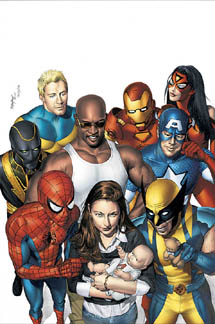 You might remember this latest issue of The Pulse, # 11, for making waves around the comic-news world. That’s right—this is that issue, the one everyone was talking about a couple months back, when it was announced that it would feature the return of D-Man.
You might remember this latest issue of The Pulse, # 11, for making waves around the comic-news world. That’s right—this is that issue, the one everyone was talking about a couple months back, when it was announced that it would feature the return of D-Man.
No, wait—it was Jessica Jones’s baby. That’s right. I got it confused with what I was excited about. When the cover to this issue was released, there was a furor over the race of the baby on the cover—since the mother, Jessica, is white and the father, Luke Cage, is black, then it stood to reason that the child wouldn’t be as amazingly pale as depicted on the cover. That’s been corrected in the printed version, but only nominally—the skin tone looks vaguely brown to me, but I’m also color blind, so I’m not sure I’m the best judge. Either way, it’s neither here nor there in regards to the comic book, because all that happens inside is Jessica’s water breaking.
Let’s backtrack and catch up everyone who walked in late. The Pulse is Brian Michael Bendis’s all-ages sequel to his eminently readable P.I.-in-the-Marvel-U title, Alias, and because of that it doesn’t feature any curses or, y’know, anal. What it does feature is the former titular heroine, Jessica Jones, as a creative consultant to the Daily Bugle on their new Sunday super-hero supplement, called The Pulse. That means, as regular guest stars and co-stars are such Marvel supporting luminaries, J. Jonah Jameson, Ben Urich, and Kat Ferrell.
See, I’ve always had a soft-spot for the also-rans, particularly in the supporting character category. I’m the person who won’t shut up and who always tries to point out That Guy in movies and television shows. I have a fond memory of Paul Giamatti years before he was headlining Sundance-award-winning features, or trying to have one over on Frankie Muniz (which, to be fair, I think we’ve all tried at some point—but he’s just too clever!). Subsequently, when I read Frank Miller’s Daredevil, I had a real soft spot for guys like Ben Urich.
I’m not alone here, apparently, as Bendis has built an entire vanity book around them. What should you expect, then, reading this issue? A very-pregnant Jessica Jones having an extended conversation with Sue Storm about the nature of motherhood in light of being a super-powered target, and Ben Urich investigating a store robbery broken up by what he was told was Daredevil, but figured out was actually D-Man. That’s right—the smelly, homeless guy who, at one point, was an Avenger, and wears an old Daredevil costume and old Wolverine mask. That’s it.
So, why am I rating it so high? Could be the return of Michael Gaydos to the scene—he was the artist on the full run of Alias, and he brings that same command of gesture and characterization here. The pages are never boring to look at, even though they’re filled with people yakking and thinking and not a whole lot else. Matt Hollingsworth provides an interesting color palate, though adds an annoying uniform texture to everything that gives the entire visual plane the same wrinkled look. I find it hard to believe someone’s shirt, skin, shoes and the carpet their standing on all feel the same, but I digress.
Either way, it’s a talking heads book set firmly in a super-verse, and I’m as happy as a kitten, myself.
THREE AND A HALF OUT OF FIVE VIKINGS

“Karma Incorporated” Comes Around and Goes Around
By Rob Glenn
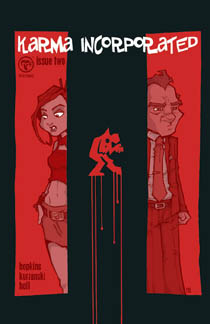 We all dream of our enemies getting their perceived comeuppance. Of course, more often than not, they are people who hold some sort of power over us. Otherwise we wouldn’t be dreaming about them getting a punch in the nose, we’d be the ones administering said punch. That’s where Karma Incorporated comes in. With what is assumed to be a hefty fee, they will research your intended victim and construct "one of those days" that can in no way be tracked back to you. A target’s day may start with a cold shower because the breaker for the water heater had been mysteriously tripped. Upon entering their local public transportation they might find they don’t seem to have exact change. A doorknob my come away from their office door. Nothing life-threatening; just minor inconveniences that add up to a very bad day.
We all dream of our enemies getting their perceived comeuppance. Of course, more often than not, they are people who hold some sort of power over us. Otherwise we wouldn’t be dreaming about them getting a punch in the nose, we’d be the ones administering said punch. That’s where Karma Incorporated comes in. With what is assumed to be a hefty fee, they will research your intended victim and construct "one of those days" that can in no way be tracked back to you. A target’s day may start with a cold shower because the breaker for the water heater had been mysteriously tripped. Upon entering their local public transportation they might find they don’t seem to have exact change. A doorknob my come away from their office door. Nothing life-threatening; just minor inconveniences that add up to a very bad day.
One would have to be careful when created a tailor made bad day. Research is the key. Removing the spark plugs from a car enthusiast’s vehicle could be easily overcome and, worse, may give the victim a sense of accomplishment. This is why Karma Incorporated has a staff of unorthodox detectives. They look at a victim’s daily life and find a way to exploit weaknesses. If a man is proud of his punctuality, adjusting all the clocks in his house makes much more sense than switching his toothpaste with hemmorrhoid cream.
You’d think the staff of a venture calling itself "Karma Inc." would realize the ramifications of putting so much energy into creating detrimental scenarios for others. By issue two, they’re starting to catch on. Writer David Hopkins (Dead@17) has a former customer-turned-victim discover from whence his predicament arises. Then things turn ugly. The art by Tom Kurzanski is quite incongruous with the material. Having the disgruntled ex-customer resemble Michael Douglas’ character from the film Falling Down is very clever. However, the character designs are such that the cast in this play have overlarge heads with wispy thin bodies. Many books have utilized a simplistic approach to the art which when done right causes an interesting friction when following a complex story. Most Manga is a study in this. Kurzinski’s work here has an uncanny resemblance to the Bratz line of children’s dolls aimed at the neo-girl power crowd. I fear most readers won’t be able to get past this.
Karma Incorporated #2 is on shelves even as you read this.
TWO OUT OF FIVE VIKINGS

Ennis Plugs Different Variables into “The Punisher”, Gets Entertaining Result
By Russell Paulette
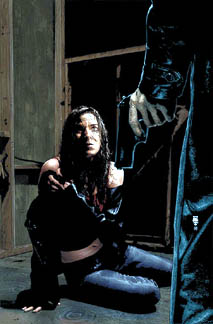 On the one hand, I imagine writing the Punisher might be difficult. How many different variations on “will kill bad guys” are there to play? Since issue # 25 is the first part of a new storyline, titled “The Slavers,” the answer to that question is, apparently, “lots.”
On the one hand, I imagine writing the Punisher might be difficult. How many different variations on “will kill bad guys” are there to play? Since issue # 25 is the first part of a new storyline, titled “The Slavers,” the answer to that question is, apparently, “lots.”
Part of what has made Garth Ennis’s take on the Punisher work so well, particularly since the mature-readers move, is the fact that the Punisher is one-note. He kills. Period.
Again, you would think this would get boring, but Ennis is able-bodied enough to make it work, and a large part of that is that he shifts the focus largely away from Castle onto a rotating cast of supporting characters, each pertinent to the plot-at-hand. In this storyline’s case, it’s a pair of beat cops—one gay and black, the other white and full of liberal guilt—and sets them in orbit around the Punisher. He adds a third subplot, of an eager homicide detective in bed with the Russian mob who sets the wheels in motion for a Punisher task force. In the main plot, Castle saves a young girl from hoodlums, only to find out about a horrible tragedy from her past, one that, presumably, ties into the title. The issue ends with that pitch perfect note of “When she was done, I knew a lot of men would have to die.”
That’s it, in a nutshell—the entire book, the entire run. Here’s a man who has found, through altruism and black-and-white moralizing, the way he can rationalize killing lots and lots of people to himself. He’s a picky serial killer, basically. And somehow it all works, because in Ennis’s hands the book becomes elevated to something more akin to Mickey Spillaine novels. Ask the right kind of people, and it’s not much of an elevation, but in reality it just sets the generic parameters for the book, and within those parameters Ennis can have a ball just mixing and matching to find the right hook and the right execution.
Artwise, Leandro Fernandez has been the ersatz artist for the run, and his work here is solid and respectable. Occasionally, there’s an expression or piece of anatomy that’s wonky or ill-advised, but for the most part he pulls off the atmosphere and grit that the material requires: the Punisher is a menacing shape in the rain, all eyebrows and skull-shirt. In terms of storytelling, Fernandez pulls everything off rather well, keeping his framing and pacing largely cinematic, which works for Ennis’s dialogue-driven script.
A good looking package, all around.
FOUR OUT OF FIVE VIKINGS

Ellis Offers New Formatting in a Tentpole Genre with “Fell”
By Russell Paulette
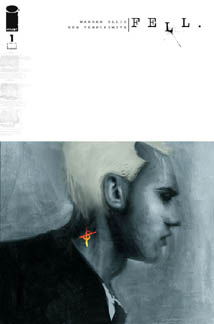 The parallels to his Apparat offering, Frank Ironwine (reviewed back in the day RIGHT HERE), notwithstanding, Warren Ellis’s latest offering from Image is off to a strong start. First off, it’s notable that the first issue of Fell has a lower pricepoint for a lower page count, but don’t let that scare you off at all. Second, Ellis is working with Ben “30 Days of Night” Templesmith, so don’t let that scare you off, either, if his work hasn’t done much for you in the past.
The parallels to his Apparat offering, Frank Ironwine (reviewed back in the day RIGHT HERE), notwithstanding, Warren Ellis’s latest offering from Image is off to a strong start. First off, it’s notable that the first issue of Fell has a lower pricepoint for a lower page count, but don’t let that scare you off at all. Second, Ellis is working with Ben “30 Days of Night” Templesmith, so don’t let that scare you off, either, if his work hasn’t done much for you in the past.
In short, Ellis’s Fell is a breath of fresh air.
In a lot of ways, Fell is an experiment—it’s a different format, with 16-pages of self-contained story with a thick appendix of miscellany and a lower price tag. According to Ellis’s press releases, the plotting is also a little free-form, in that he’s approaching the book as an open ended process, with no major arc in mind. Templesmith’s art has always felt, to me, like an artist pulling from whatever medium he could, never deciding if he likes computer, or oils, or watercolor, or pastels so, hell, he’ll just use ‘em all. So, in that sense, it’s pretty experimental feeling, but not in a way that makes you feel left out or lost at all.
The story concerns Detective Richard Fell, newly transferred to Snowtown—which is the part of the city no one wants to live in, let alone investigate death. It’s the part of town with only three-and-a-half homicide detectives to the precinct, bartenders with branding irons, and estranged wives with creative applications for scotch drinking. On top of that, there’s a pervading sense of dread that hangs over every situation Fell finds himself in, and this keeps the atmosphere of the story in league with Templesmith’s diffuse artwork. Detailing the plot would give too much away, but suffice to say, Fell uses his powers of intuition and observation more than a trigger finger and fleet feet and, in that sense, it maintains the humanism of Ironwine.
Because the script is lean, however, some of Ellis’s weaknesses are illuminated more than they usually are—the outrageous non-sequitur-as-thumbnail-characterization was a little annoying, particularly with the police captain—but not enough to give the book a black eye.
Templesmith’s artwork here is assured as it is free-form, and shows a greater sense of clarity than much of his IDW work. There’s a sense that he’s reined it in a bit with Ellis’s script, keeping the storytelling clear and the characters placed in the frame in ways that make sense but also contribute to the atmosphere. Remarkably, the sixteen-page format also feels dense, as both writer and artist pack each page with enough information to make you linger in all the right places without feeling like you’re getting short-changed on the reading experience.
Overall, this is an experiment that, by the results of the first issue, is working and working well. From the cover to the back pages, this is a comic that lets you sink into its pervasive atmosphere and linger for a little while.
FIVE OUT OF FIVE VIKINGS

![]()

Lost Dogs
(Ashtray Press)
By Graig Kent
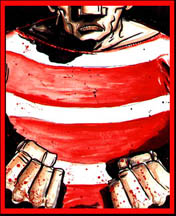 About the stupidest comparison I could make for Lost Dogs is that it’s a crossing of The Punisher with Unleashed. I mean, it’s absolutely nothing like those films, but its story hits on some familiar notes.
About the stupidest comparison I could make for Lost Dogs is that it’s a crossing of The Punisher with Unleashed. I mean, it’s absolutely nothing like those films, but its story hits on some familiar notes.
Set in a yesterday time of gas lanterns and horse-and-buggies, the main character of the book is a hulking brute of a farmer in a red and white candy striped shirt. He’s a loving husband and father who make a promise to his little girl that he will take her to the big city to see the boats. When they finally make it, a gang of thugs comes out from the darkness and murders the girl, takes his wife and leaves him for dead, stabbed and pushed in the river.
A little while later he’s found by fishermen who sell him to an elderly man, a gambler who gives the brute some unexpected news, news which will make the man fight for his life if, perhaps, he were entered into a violent bare-knuckles boxing competition.
It’s not at all an action story, but rather a drama full of immense pathos and sorrow. It’s actually quite difficult to read and enjoy because it is so immensely dark and really without joy. Even the early scenes of a happy father and daughter are overwhelmed by writer/artist Jeff Lemire’s heavy line. Working with a thick ink brush uses broad strokes and simplified forms to tell his tale. It’s thick with black and grey washes, with the occasional pop of red in for the brute’s striped shirt, or drops of blood.
Lemire is one of this year’s Xeric Grant recipients, from which sprang Lost Dogs. It’s an intriguing work by an artist with a distinctive style, but the work is perhaps just a little too rough and too bleak for my tastes.
(available from www.ashtraypress.com)
THREE OUT OF FIVE VIKINGS

Spiral-Bound
(Top Shelf Productions)
By Graig Kent
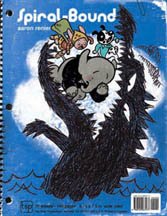 The format of this book was what drew me to it. It wasn’t the quotes of praise from Lemony Snicket (A Series of Unfortunate Events) or Tony Millionaire (Sock Monkey) or Dav Pilkey (Captain Underpants) – each who quite prominently write oddball children’s fiction which I quite enjoy – but rather the faux spiral-bound notebook looking cover, complete with rounded edges, the appearance of binder ring holes, the spiral-wire restraining a pencil on the spine, and just that grade school workbook charm. Even the page edges had that lined paper appearance, but I was ultimately disappointed to find, inside, that the artwork wasn’t done on actual lined paper.
The format of this book was what drew me to it. It wasn’t the quotes of praise from Lemony Snicket (A Series of Unfortunate Events) or Tony Millionaire (Sock Monkey) or Dav Pilkey (Captain Underpants) – each who quite prominently write oddball children’s fiction which I quite enjoy – but rather the faux spiral-bound notebook looking cover, complete with rounded edges, the appearance of binder ring holes, the spiral-wire restraining a pencil on the spine, and just that grade school workbook charm. Even the page edges had that lined paper appearance, but I was ultimately disappointed to find, inside, that the artwork wasn’t done on actual lined paper.
It was a crushing blow, for sure, but I still knew nothing about the story or the characters or the world that artist/writer Aaron Renier had created. I though I should actually read the thing before I pass judgement. So I turned the pages and soaked it all in.
Immediately it struck me that I was not the target audience for this book. It’s truly a book for children, with a wide-eyed spirited premise and plucky young characters, something the kids are supposed to relate to or look up to. Plus, it’s got anthropomorphic animals in it, and I’m really not a huge fan of animals acting like humans anymore. Unless they’re Muppets. I’ll never outgrow the Muppets.
In the story, Ana (a rabbit) becomes involved in the local underground newspaper with her photographer friend Emily (a sparrow) and begins investigating the legend of the swamp monster that has apparently kept the town in fear for decades. Turnip (an elephant) joins his friend Stucky (a dog) in an art class, where their teacher, Ms. Scrimshaw (a whale), is preparing an installation for the swamplands in hopes of taking back the area from fear and to show the town there’s no monster. Of course, Turnip’s father and the other townsfolk catch wind of the plan and threaten to exile Ms. Scrimshaw from the town, so it’s up to Ana and Emily to expose the truth.
There are some wildly inventive elements to Renier’s Spiral-Bound world, including the underground network, Emily and Ana’s “Turnip” costume, and Ms. Scrimshaw’s snow-globe/tractor in which she lives and transports herself around town. The story is fun but slow to get going, however the last act really brings it all together with a neat surprise at the beginning and some wonderful visuals. The characters are well developed with quite distinctive personalities, however, I found the adult supporting characters to be immensely more appealing, as they have the opportunity to be crass, wise, overbearing, nurturing and patronizing, amongst other traits.
Reiner’s art really took me back to my childhood, having a very Richard Scarry feel to it. While I found the pacing to be uneven at spots, overall the story has warmth, sincerity, and a genuine understanding of pathos and adventure. This is a magnificent book for parents looking for a good bedtime read for their young kids or something to get a young reader active with.
FOUR OUT OF FIVE VIKINGS

![]()

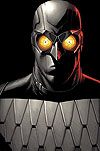 Supreme Power: Nighthawk # 1 of 6 (Marvel) – To fill in the gap between the Hot Parts and the the Kid-Friendly version of Supreme Power, Marvel’s running two MAX minis, each featuring a central character from the series. Nighthawk is the one not written by Straczynski, rather it’s Daniel Way and Steve Dillon, whom some of you might remember from last year’s Bullseye: Greatest Hits mini-series. That’s an awfully long introduction for a bulleted review, I’ll admit, but in this case it’s warranted. If you haven’t read any Supreme Power, you won’t be too lost here, as Way and Dillon present a story in pure urban vigilante mode—our title protagonist is ruthless, fascist, and out for blood, particularly if it’s tinged with platelets of racism. There’s a nice crisis that gets set up rather quickly, along with lots of noses and faces getting crushed in that Steve Dillon way. Fun for what it is, but ultimately forgettable. – Russell
Supreme Power: Nighthawk # 1 of 6 (Marvel) – To fill in the gap between the Hot Parts and the the Kid-Friendly version of Supreme Power, Marvel’s running two MAX minis, each featuring a central character from the series. Nighthawk is the one not written by Straczynski, rather it’s Daniel Way and Steve Dillon, whom some of you might remember from last year’s Bullseye: Greatest Hits mini-series. That’s an awfully long introduction for a bulleted review, I’ll admit, but in this case it’s warranted. If you haven’t read any Supreme Power, you won’t be too lost here, as Way and Dillon present a story in pure urban vigilante mode—our title protagonist is ruthless, fascist, and out for blood, particularly if it’s tinged with platelets of racism. There’s a nice crisis that gets set up rather quickly, along with lots of noses and faces getting crushed in that Steve Dillon way. Fun for what it is, but ultimately forgettable. – Russell
RAID RATING:
Seven Soldiers: The Manhattan Guardian #4 (DC) – Who’s the guy in control of the Guardian Newspaper? Well, Jake finally finds out as he attempts to resign his position, face-to-face. But resigning just isn’t an option, as the history of the Newsboy Army threatens to repeat itself when the Sheeda attack again, gunning straight for the Editor-In-Chief. The second Morrison mini-series comes to a close, but things are hardly wrapped up. While Shining Knight just kind of confused me, The Manhattan Guardian is just pure fun in a shiny metal helmet. Cameron Stewart’s next gig should be drawing the most high profile book on the stands. The guy is a superstar. – Graig
RAID RATING:

 The Authority: The Magnificent Kevin # 1 of 5 (DC/Wildstorm) – If anyone doubted Garth Ennis’s disdain for superheroes, let this be submitted as Exhibit F. As the third project he’s done featuring his beleaguered, malcontent SAS agent Kevin being suckered into service with the Authority, Ennis returns to familiar territory—namely, making the Authority look like a bunch of assholes. The joy of any of these Kevin books—in addition to the too-cool Authority shtick played as farce—is really the character of Kevin, himself. Ennis achieves an odd tone where a) everything’s hyper-goofy and off-the-wall, then b) things sober up for an examination of the psychological effects of being one of the best-trained government killers in the world. It’s an odd balancing act—one Ennis doesn’t necessarily succeed at—but one that remains entertaining the whole way. One half of the book’s a cartoon; the other a character study, and it’s all drawn in fine style by Carlos Ezquerra. – Russell
The Authority: The Magnificent Kevin # 1 of 5 (DC/Wildstorm) – If anyone doubted Garth Ennis’s disdain for superheroes, let this be submitted as Exhibit F. As the third project he’s done featuring his beleaguered, malcontent SAS agent Kevin being suckered into service with the Authority, Ennis returns to familiar territory—namely, making the Authority look like a bunch of assholes. The joy of any of these Kevin books—in addition to the too-cool Authority shtick played as farce—is really the character of Kevin, himself. Ennis achieves an odd tone where a) everything’s hyper-goofy and off-the-wall, then b) things sober up for an examination of the psychological effects of being one of the best-trained government killers in the world. It’s an odd balancing act—one Ennis doesn’t necessarily succeed at—but one that remains entertaining the whole way. One half of the book’s a cartoon; the other a character study, and it’s all drawn in fine style by Carlos Ezquerra. – Russell
RAID RATING:
 Villains United #5 (DC) – All right, dust off your copies of Who’s Who, or break out your DC Comics Encyclopedia, or at least make yourself familiar with the old Crisis on Infinite Earths because things are now officially in DC continuity nuance mode. Bad guys galore get set battle our glorious bad guys (know collectively as the Secret Six), when the Six press a little too hard against Luthor’s assembly of Super-Villains. With Deathstroke leading the charge of a hundred super-meanies, it’s a bad time for the Six to fall apart, with Deadshot and Catman going at it, Cheshire proving to me more of a bitch than a cat, and a traitor in the group revealed. And many pieces of the puzzle of Infinite Crisis start to fall in place, if you pay close enough attention. Amidst ever tightening reigns as the Crisis draws forth, Gail Simone still manages to deliver a wildly entertaining book, even if you don’t have a clue as to who’s what and where’s when. – Graig
Villains United #5 (DC) – All right, dust off your copies of Who’s Who, or break out your DC Comics Encyclopedia, or at least make yourself familiar with the old Crisis on Infinite Earths because things are now officially in DC continuity nuance mode. Bad guys galore get set battle our glorious bad guys (know collectively as the Secret Six), when the Six press a little too hard against Luthor’s assembly of Super-Villains. With Deathstroke leading the charge of a hundred super-meanies, it’s a bad time for the Six to fall apart, with Deadshot and Catman going at it, Cheshire proving to me more of a bitch than a cat, and a traitor in the group revealed. And many pieces of the puzzle of Infinite Crisis start to fall in place, if you pay close enough attention. Amidst ever tightening reigns as the Crisis draws forth, Gail Simone still manages to deliver a wildly entertaining book, even if you don’t have a clue as to who’s what and where’s when. – Graig
RAID RATING:
 Superman/Shazam!: First Thunder # 1 of 4 (DC) – Judd Winick writes a revisionist first meeting between Superman and Shazam, and does an able-bodied job of it, especially in the characterizations of the two headliners, but who cares?!? Josh Middleton draws the damn thing, and it’s so pretty I became constipated. Middleton’s perfected a flat-tone, open-formed, thick-outlined look to his work—philistines will call it ‘cartoony’ or ‘animated’ looking—and there’s something undeniably appealing to it, despite the fact that it’s obviously tainted by computer influence. Middleton’s the kind of artist able to make a CPU a tool and not a crutch, and that, combined with an impressive command of expression, composition and just plain style, makes the artwork on this thing worth three-and-a-half bucks. – Russell
Superman/Shazam!: First Thunder # 1 of 4 (DC) – Judd Winick writes a revisionist first meeting between Superman and Shazam, and does an able-bodied job of it, especially in the characterizations of the two headliners, but who cares?!? Josh Middleton draws the damn thing, and it’s so pretty I became constipated. Middleton’s perfected a flat-tone, open-formed, thick-outlined look to his work—philistines will call it ‘cartoony’ or ‘animated’ looking—and there’s something undeniably appealing to it, despite the fact that it’s obviously tainted by computer influence. Middleton’s the kind of artist able to make a CPU a tool and not a crutch, and that, combined with an impressive command of expression, composition and just plain style, makes the artwork on this thing worth three-and-a-half bucks. – Russell
RAID RATING:
 The Bakers #1 (Kyle Baker Publishing) – Kyle Baker turns his “autobiographical” family cartoons into a regular, ongoing series. With a Mad Magazine skewing Family Circus sensibility, Baker’s gifted hand brings a sweet and fun collection of family comedy skits that would make the late Bill Gaines smile. While it doesn’t any of the edginess of Why I Hate Saturn or the madcap zaniness of The Cowboy Wally Show, The Bakers yet again proves just how diverse a talent Baker actually is, not just at illustration and storytelling, but also comedy, slapstick, and sight gags. Nothing earth-shattering but still highly enjoyable. –Graig
The Bakers #1 (Kyle Baker Publishing) – Kyle Baker turns his “autobiographical” family cartoons into a regular, ongoing series. With a Mad Magazine skewing Family Circus sensibility, Baker’s gifted hand brings a sweet and fun collection of family comedy skits that would make the late Bill Gaines smile. While it doesn’t any of the edginess of Why I Hate Saturn or the madcap zaniness of The Cowboy Wally Show, The Bakers yet again proves just how diverse a talent Baker actually is, not just at illustration and storytelling, but also comedy, slapstick, and sight gags. Nothing earth-shattering but still highly enjoyable. –Graig
RAID RATING:
 Detective Comics # 811 (DC) – Back on form after last month’s Bat-over, David Lapham and Ramon Bachs continue their year-long odyssey. This is about nine-or-so issues into Lapham’s Byzantine plot, so trying to recount it all for you at this point would be fruitless. Regardless, Lapham makes the scenario compelling enough—Batman undercover with dockworkers in a low-income neighborhood for, what, three issues now?—and has a knack for opening up the entire setting with mini-vignettes that help cast a wide net of focus on the entire proceedings. Standing out with this issue, however, is Bachs’s artwork, which ranges in its subtlety, as he’s given neighborhood trials and tribulations to draw. It’s a compelling little character drama shrouded in a much larger conspiracy/mystery arc that has me hooked until the end, despite the fact that I can’t really remember much about the conspiracy or the mystery. Good stuff. – Russell
Detective Comics # 811 (DC) – Back on form after last month’s Bat-over, David Lapham and Ramon Bachs continue their year-long odyssey. This is about nine-or-so issues into Lapham’s Byzantine plot, so trying to recount it all for you at this point would be fruitless. Regardless, Lapham makes the scenario compelling enough—Batman undercover with dockworkers in a low-income neighborhood for, what, three issues now?—and has a knack for opening up the entire setting with mini-vignettes that help cast a wide net of focus on the entire proceedings. Standing out with this issue, however, is Bachs’s artwork, which ranges in its subtlety, as he’s given neighborhood trials and tribulations to draw. It’s a compelling little character drama shrouded in a much larger conspiracy/mystery arc that has me hooked until the end, despite the fact that I can’t really remember much about the conspiracy or the mystery. Good stuff. – Russell
RAID RATING:
 Gotham Central # 35 (DC) – Another mid-arc release from the Bat-offices, this title has been a favorite around Viking Central for thirty-five issues now, and this one’s no exception. The plot centers on the homicide cops trying to track down a killer who keeps offing teenagers and dumping their bodies fully dressed in Robin-gear. Just when the detectives have their wits about them, and stop saying “WTF?!?”, Messers. Greg Rucka and Ed Brubaker throw them a curve in the final pages, which brings a long-playing supporting character into doubt. Consistently, one of the strengths of the book has been the tag-team efforts by the writers, and Kano and Stefano Gaudino’s artwork also takes the cake here, serving up a perfectly rendered delivery on the premise. Truly a good piece of work, even with the capes. – Russell
Gotham Central # 35 (DC) – Another mid-arc release from the Bat-offices, this title has been a favorite around Viking Central for thirty-five issues now, and this one’s no exception. The plot centers on the homicide cops trying to track down a killer who keeps offing teenagers and dumping their bodies fully dressed in Robin-gear. Just when the detectives have their wits about them, and stop saying “WTF?!?”, Messers. Greg Rucka and Ed Brubaker throw them a curve in the final pages, which brings a long-playing supporting character into doubt. Consistently, one of the strengths of the book has been the tag-team efforts by the writers, and Kano and Stefano Gaudino’s artwork also takes the cake here, serving up a perfectly rendered delivery on the premise. Truly a good piece of work, even with the capes. – Russell
RAID RATING:
So ends this accounting of valiant warriors and high adventure! Return next week to honor still more comics. Praise Odin.
HAVE A COMIC YOU WANT TO SUBMIT FOR REVIEW? Contact Sean at scfahey@yahoo.com.
To discuss this column and all things Nordic, you may contact Sean at scfahey@yahoo.com , Devon at thedevonsanders@yahoo.com , Dave at dave@chud.com , Russell at inadvertent@mail.com , Rob at poprob@gmail.com and Graig at graig@geekent.com.